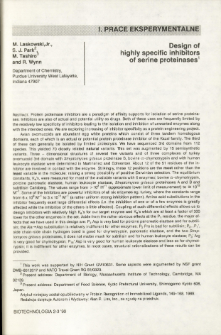- Wyszukaj w całym Repozytorium
- Piśmiennictwo i mapy
- Archeologia
- Baza Młynów
- Nauki przyrodnicze
Wyszukiwanie zaawansowane
Wyszukiwanie zaawansowane
Wyszukiwanie zaawansowane
Wyszukiwanie zaawansowane
Wyszukiwanie zaawansowane

Obiekt
Tytuł: Design of highly specific inhibitors of serine proteinases
Twórca:
Laskowski, Michael Jr. ; Park, S. J. ; Tashiro, M. ; Wynn, R.
Data wydania/powstania:
Typ zasobu:
Inny tytuł:
Design of highly specific inhibitors of serine proteinases
Wydawca:
Komitet Biotechnologii PAN ; Instytut Chemii Bioorganicznej PAN
Abstrakt:
Protein proteinase inhibitors are a paradigm of affinity supports for isolation of serine proteina- ses. Inhibitors are also of actual and potential utility as drugs. Both of these uses are frequently limited by the relatively low specificity of inhibitors leading to the isolation and inhibition of unwanted enzymes along with the intended ones. We are exploring increasing of inhibitor specificity as a protein engineering project.Avian ovomucoids are abundant egg white proteins which consist of three tandem homologous domains, each of which is an actual or potential protein proteinase inhibitor of the Kazal family. The third of these can generally be isolated by limited proteolysis. We have sequenced 3rd domains from 112 species. This yielded 70 closely related natural variants. This set was augmented by 15 semisynthetic variants. Three - dimensional structures of several free variants and of three complexes of turkey ovomucoid 3rd domain with Streptomyces griseus proteinase B, bovine a-chymotrypsin and with human leukocyte elastase were determined in Martinsried and Edmonton. About 12 of the 51 residues of the inhibitor are involved in contact with the enzyme. Strikingly, these 12 positions are the most rather than the least variable in the molecule; raising a strong possibility of positive Darwinian selection. The equilibrium constants, Ka’s, were measured for most of the available variants with 6 enzymes; bovine a-chymotrypsin, porcine pancreatic elastase, human leukocyte elastase, Streptomyces griseus proteinases A and B and subtilisin Carlsberg. The values range from >10^ M“’ (approximate lower limit of measurement) to 10’^ Some of the inhibitors are powerful inhibitors of all six enzymes eg. turkey, where the constants range from 6 X 10® M“^ to 3 x 10^’ (a rather uniform strong inhibition pattern). Amino acid substitutions in the inhibitor frequently exert large differential effects (i.e. the inhibition of one or of a few enzymes is greatly affected while the inhibition of the others is little affected). Coupling of such differential effects allows us to design inhibitors with relatively high Kg’s for our target enzyme and Ka’s which are at least a factor of 300 lower for the other enzymes in the set. Aside from the rather obvious effects at the Pi residue, the major effects that we have used in this design are; P4 Asp is very bad for porcine pancreatic elastase and for subtilisin; the Ala-»Asp substitution is relatively indifferent for other enzymes; P2 Pro is bad for subtilisin; P2-.Pi’, side chain-side chain hydrogen bond is good for chymotrypsin, pancreatic elastase, and the two Streptomyces griseus proteinases, it does not matter much for subtilisin and for human leukocyte elastase; Pa’ Arg is very good for chymotrypsin; P^e’ Asp is very good for human leukocyte elastase and less so for chymotrypsin; it is indifferent for other enzymes. In most cases, structural rationalizations of these results can be provided.
Czasopismo/Seria/cykl:
Biotechnologia, vol.9-8, 3-2 (1990)-.
Tom:
Zeszyt:
Strona pocz.:
Strona końc.:
Szczegółowy typ zasobu:
Format:
Identyfikator zasobu:
0860-7796 ; oai:rcin.org.pl:185995 ; IChB B-06
Źródło:
Biblioteka Instytutu Chemii Bioorganicznej PAN
Język:
Język streszczenia:
Zakres czasowy:
Prawa:
Licencja Creative Commons Uznanie autorstwa-Na tych samych warunkach 4.0
Zasady wykorzystania:
Digitalizacja:
Instytut Chemii Bioorganicznej Polskiej Akademii Nauk
Lokalizacja oryginału:
Instytut Chemii Bioorganicznej Polskiej Akademii Nauk
Dofinansowane ze środków:
Dostęp:
Kolekcje, do których przypisany jest obiekt:
- Repozytorium Cyfrowe Instytutów Naukowych > Kolekcje Partnerów > Instytut Chemii Bioorganicznej PAN
- Repozytorium Cyfrowe Instytutów Naukowych > Kolekcje Partnerów > Instytut Chemii Bioorganicznej PAN > Artykuły
- Repozytorium Cyfrowe Instytutów Naukowych > Piśmiennictwo
- Repozytorium Cyfrowe Instytutów Naukowych > Piśmiennictwo > Czasopisma/Artykuły
Data ostatniej modyfikacji:
23 kwi 2021
Data dodania obiektu:
23 kwi 2021
Liczba pobrań / odtworzeń:
52
Wszystkie dostępne wersje tego obiektu:
https://rcin.org.pl./publication/218343
Wyświetl opis w formacie RDF:
Wyświetl opis w formacie RDFa:
Wyświetl opis w formacie OAI-PMH:
| Nazwa wydania | Data |
|---|---|
| Design of highly specific inhibitors of serine proteinases | 23 kwi 2021 |
Obiekty Podobne
Borkowska, Bożenna
Ziółkowski, Piotr Babula- Skowrońska, Danuta Kaczmarek, Małgorzata Cieśla, Agata Sadowski, Jan
Laskowski, Michael Jr.
Nowak, Jacek K.

 INSTYTUT ARCHEOLOGII I ETNOLOGII POLSKIEJ AKADEMII NAUK
INSTYTUT ARCHEOLOGII I ETNOLOGII POLSKIEJ AKADEMII NAUK
 INSTYTUT BADAŃ LITERACKICH POLSKIEJ AKADEMII NAUK
INSTYTUT BADAŃ LITERACKICH POLSKIEJ AKADEMII NAUK
 INSTYTUT BADAWCZY LEŚNICTWA
INSTYTUT BADAWCZY LEŚNICTWA
 INSTYTUT BIOLOGII DOŚWIADCZALNEJ IM. MARCELEGO NENCKIEGO POLSKIEJ AKADEMII NAUK
INSTYTUT BIOLOGII DOŚWIADCZALNEJ IM. MARCELEGO NENCKIEGO POLSKIEJ AKADEMII NAUK
 INSTYTUT BIOLOGII SSAKÓW POLSKIEJ AKADEMII NAUK
INSTYTUT BIOLOGII SSAKÓW POLSKIEJ AKADEMII NAUK
 INSTYTUT CHEMII FIZYCZNEJ PAN
INSTYTUT CHEMII FIZYCZNEJ PAN
 INSTYTUT CHEMII ORGANICZNEJ PAN
INSTYTUT CHEMII ORGANICZNEJ PAN
 INSTYTUT FILOZOFII I SOCJOLOGII PAN
INSTYTUT FILOZOFII I SOCJOLOGII PAN
 INSTYTUT GEOGRAFII I PRZESTRZENNEGO ZAGOSPODAROWANIA PAN
INSTYTUT GEOGRAFII I PRZESTRZENNEGO ZAGOSPODAROWANIA PAN
 INSTYTUT HISTORII im. TADEUSZA MANTEUFFLA POLSKIEJ AKADEMII NAUK
INSTYTUT HISTORII im. TADEUSZA MANTEUFFLA POLSKIEJ AKADEMII NAUK
 INSTYTUT JĘZYKA POLSKIEGO POLSKIEJ AKADEMII NAUK
INSTYTUT JĘZYKA POLSKIEGO POLSKIEJ AKADEMII NAUK
 INSTYTUT MATEMATYCZNY PAN
INSTYTUT MATEMATYCZNY PAN
 INSTYTUT MEDYCYNY DOŚWIADCZALNEJ I KLINICZNEJ IM.MIROSŁAWA MOSSAKOWSKIEGO POLSKIEJ AKADEMII NAUK
INSTYTUT MEDYCYNY DOŚWIADCZALNEJ I KLINICZNEJ IM.MIROSŁAWA MOSSAKOWSKIEGO POLSKIEJ AKADEMII NAUK
 INSTYTUT PODSTAWOWYCH PROBLEMÓW TECHNIKI PAN
INSTYTUT PODSTAWOWYCH PROBLEMÓW TECHNIKI PAN
 INSTYTUT SLAWISTYKI PAN
INSTYTUT SLAWISTYKI PAN
 SIEĆ BADAWCZA ŁUKASIEWICZ - INSTYTUT TECHNOLOGII MATERIAŁÓW ELEKTRONICZNYCH
SIEĆ BADAWCZA ŁUKASIEWICZ - INSTYTUT TECHNOLOGII MATERIAŁÓW ELEKTRONICZNYCH
 MUZEUM I INSTYTUT ZOOLOGII POLSKIEJ AKADEMII NAUK
MUZEUM I INSTYTUT ZOOLOGII POLSKIEJ AKADEMII NAUK
 INSTYTUT BADAŃ SYSTEMOWYCH PAN
INSTYTUT BADAŃ SYSTEMOWYCH PAN
 INSTYTUT BOTANIKI IM. WŁADYSŁAWA SZAFERA POLSKIEJ AKADEMII NAUK
INSTYTUT BOTANIKI IM. WŁADYSŁAWA SZAFERA POLSKIEJ AKADEMII NAUK


































